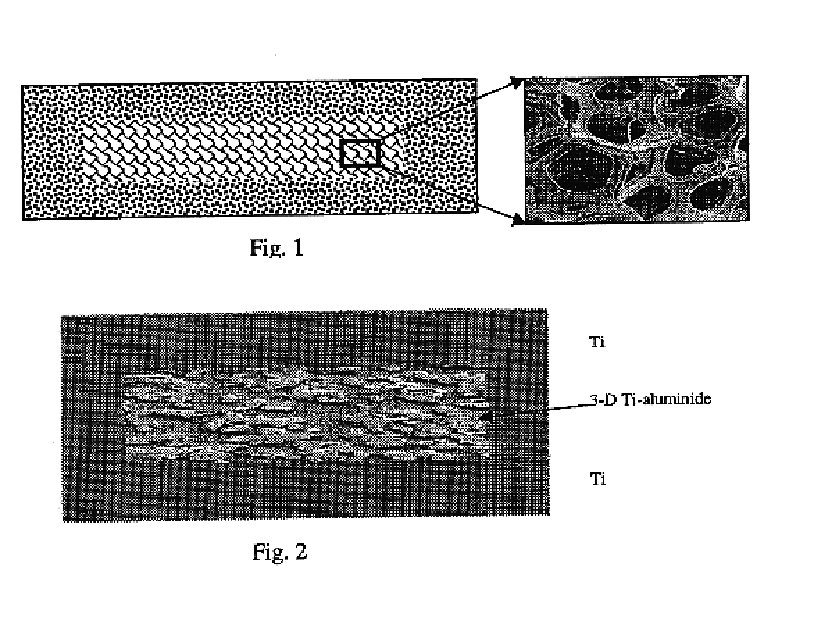High-strength metal aluminide-containing matrix composites and methods of manufacture the same
a technology of metal aluminide and composite materials, which is applied in the direction of solid-state diffusion coatings, transportation and packaging, coatings, etc., can solve the problems of high oxidation of metal aluminide alloys, low ductility, and difficult fabrication of thin-gauge gamma-titanium aluminide sheets and shaped articles
- Summary
- Abstract
- Description
- Claims
- Application Information
AI Technical Summary
Benefits of technology
Problems solved by technology
Method used
Image
Examples
example 1
The flat workpiece measuring 6″×12″×0.525″ of aluminum foam having open porosity of ˜80 vol. % was filled with the CP titanium powder having a particle size of −325 mesh. The obtained flat aluminum skeleton / titanium powder preform was hot pressed at 1250° C. and 150 kg / cm2 for 1 hour. The pressure was maintained from 12 to 150 kg / cm2 during the heating process that ranged from 500 to 1250° C.
The reaction between the titanium powder and aluminum foam started at ˜650° C. and resulted in the formation of a skeleton-like titanium-aluminide structure. The resulting composite sheet 0.24″ thick was fully dense, with a measured density of 4.1 g / cm3. The microstructure of the composite consists of ductile titanium matrix and reinforcing a 3-D titanium aluminide structure (FIG. 2).
Samples 3″×0.5″ were cut from the edge and central part of the sheet to measure Vickers microhardness and ultimate tensile strength at 20° C. and 500° C.
The particle size of the titanium powder, size and porosity of...
example 2
The same flat workpiece of aluminum foam as in Example 1 was filled with the CP titanium powder. The obtained flat aluminum skeleton / titanium powder preform was cold rolled to the thickness of 0.4″, sintered at 1100° C., and then hot pressed for 1 hour at 1250° C. and 150 kg / cm2. The pressure was maintained from 12 to 150 kg / cm2 during the heating process that ranged from 500 to 1250° C.
The reaction between titanium powder and aluminum foam started at ˜650° C. during sintering and resulted in the formation of a skeleton-like titanium aluminide structure. The resulting hot-pressed composite sheet 0.2″ thick was fully dense, with a measured density of 4.1 g / cm3. The microstructure of the composite consists of ductile titanium matrix and reinforcing 3-D titanium aluminide structure. The resulting titanium / titanium aluminide composite material lost only 21% of tensile strength at the testing temperature of 500° C. versus the strength at 20° C.
example 3
The same flat workpiece of aluminum foam as in Example 1 was filled with pre-alloyed Ti-6Al-4V alloy powder. The obtained flat aluminum skeleton / titanium alloy powder preform was sintered at 1100° C., and then hot pressed for 1 hour at 1250° C. and 150 kg / cm2. The pressure was maintained from 12 to 150 kg / cm2 during the heating process that ranged from 500 to 1250° C.
The reaction between the titanium alloy powder and aluminum foam started at ˜650° C. during the sintering and resulted in the formation of a skeleton-like titanium-aluminide structure. The resulting hot-pressed composite sheet 0.2″ thick was fully dense, with a measured density of 4.05 g / cm3. The microstructure of the composite consists of ductile Ti-6Al-4V alloy matrix and reinforcing 3-D titanium aluminide structure. The resulting Ti-6Al-4V / titanium aluminide composite material lost only 16% of tensile strength at the testing temperature of 500° C. versus the strength at 20° C., while wrought Ti-6Al-4V alloy Grade 5 l...
PUM
| Property | Measurement | Unit |
|---|---|---|
| temperature-resistant | aaaaa | aaaaa |
| residual porosity | aaaaa | aaaaa |
| temperature | aaaaa | aaaaa |
Abstract
Description
Claims
Application Information
 Login to View More
Login to View More - R&D
- Intellectual Property
- Life Sciences
- Materials
- Tech Scout
- Unparalleled Data Quality
- Higher Quality Content
- 60% Fewer Hallucinations
Browse by: Latest US Patents, China's latest patents, Technical Efficacy Thesaurus, Application Domain, Technology Topic, Popular Technical Reports.
© 2025 PatSnap. All rights reserved.Legal|Privacy policy|Modern Slavery Act Transparency Statement|Sitemap|About US| Contact US: help@patsnap.com



